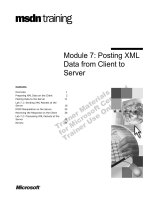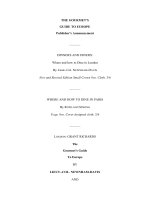The Restaurant From Concept to Operation docx
Bạn đang xem bản rút gọn của tài liệu. Xem và tải ngay bản đầy đủ của tài liệu tại đây (10.16 MB, 577 trang )
This page intentionally left blank
The
Restaurant
From Concept to Operation Sixth Edition
John R. Walker,
DBA,CHA,FMP
McKibbon Professor of Hotel and Restaurant Management
and Fulbright Senior Specialist,
University of South Florida Sarasota-Manatee
JOHN WILEY & SONS, INC.
Photos were taken by the author unless otherwise noted.
This book is printed on acid-free paper.
Copyright © 2011, 2008, 2005 by John Wiley & Sons, Inc. All rights reserved.
Published by John Wiley & Sons, Inc., Hoboken, New Jersey.
Published simultaneously in Canada.
No part of this publication may be reproduced, stored in a retrieval system, or transmitted in any
form or by any means, electronic, mechanical, photocopying, recording, scanning, or otherwise,
except as permitted under Section 107 or 108 of
the 1976 United States Copyright Act, without either the prior written permission of the Publisher,
or authorization through payment of the appropriate per-copy fee to the Copyright Clearance Center,
Inc., 222 Rosewood Drive, Danvers, MA 01923, 978-750-8400, fax 978-646-8600, or on the web at
www.copyright.com. Requests to the Publisher for permission should be addressed to the
Permissions Department, John Wiley & Sons, Inc., 111 River Street, Hoboken, NJ 07030,
201-748-6011, fax 201-748-6008, or online at />Limit of Liability/Disclaimer of Warranty: While the publisher and author have used their best efforts
in preparing this book, they make no representations or warranties with respect to the accuracy or
completeness of the contents of this book and specifically disclaim any implied warranties of
merchantability or fitness for a particular purpose. No warranty may be created or extended by sales
representatives or written sales materials. The advice and strategies contained herein may not be
suitable for your situation. You should consult with a professional where appropriate. Neither the
publisher nor author shall be liable for any loss of profit or any other commercial damages,
including but not limited to special, incidental, consequential, or other damages.
Evaluation copies are provided to qualified academics and professionals for review purposes only,
for use in their courses during the next academic year. These copies are licensed and may not be
sold or transferred to a third party. Upon completion of the review period, please return the
evaluation copy to Wiley. Return instructions and a free of charge return shipping label are available
at www.wiley.com/go/returnlabel. Outside of the United States, please contact your local
representative.
For general information on our other products and services, or technical support, please contact our
Customer Care Department within the United States at 800-762-2974, outside the United States at
317-572-3993 or fax 317-572-4002.
Wiley also publishes its books in a variety of electronic formats. Some content that appears in print
may not be available in electronic books. For more information about Wiley products, visit our Web
site at .
Library of Congress Cataloging-in-Publication Data:
Walker, John R., 1944-
The restaurant : from concept to operation / John Walker.—6th ed.
p. cm.
Includes index.
ISBN 978-0-470-62643-6 (hardback : acid-free paper) 1. Restaurant
management. I. Title.
TX911.3.M27W352 2011
647.95068—dc22
2010025727
Printed in the United States of America
10987654321
To Donald Lundberg, Ph.D.,
my mentor, colleague, and friend.
Don was admired and respected
in the halls of academia
as a scholar and pioneer
of hospitality and tourism education.
And to you, the professors, students,
and future restaurant owners, wishing
you success and happiness.
This page intentionally left blank
Contents
Preface xiii
Acknowledgments xvii
Part One Restaurants, Owners, Locations, and Concepts 1
Chapter 1 Introduction 3
Early History of Eating Out 6
French Culinary History 7
Birth of Restaurants in America 7
Challenges of Restaurant Operation 13
Buy, Build, Franchise, or Manage? 15
Starting from Scratch 19
Restaurants as Roads to Riches 20
Summary 21
Chapter 2 Kinds and Characteristics of Restaurants and Their Owners 24
Kinds and Characteristics of Restaurants 25
Sandwich Shops 30
Quick-Service Restaurants 34
Quick Casual Restaurants 35
Family Restaurants 37
Casual Restaurants 37
Fine-Dining Restaurants 39
Steakhouses 40
Seafood Restaurants 42
Ethnic Restaurants 43
Theme Restaurants 47
Coffee Shops 50
Chef-Owned Restaurants 51
Celebrity Chefs 55
Centralized Home Delivery Restaurants 58
Summary 59
vi ■ Contents
Chapter 3 Concept, Location, and Design 62
Restaurant Concepts 63
Defining the Concept and Market 68
Successful Restaurant Concepts 70
Concept Adaptation 77
Changing or Modifying a Concept 77
Copy and Improve 78
Restaurant Symbology 79
When a Concept Fails 79
Multiple-Concept Chains 80
Sequence of Restaurant Development: From Concept to Opening 80
Utility versus Pleasure 84
Degree of Service Offered 84
Time of Eating and Seat Turnover 85
Advertising and Promotion Expenditures 88
Labor Costs as a Percentage of Sales 89
Planning Decisions That Relate to Concept Development 89
Profitability 91
Mission Statement 91
Concept and Location 92
Criteria for Locating a Restaurant 93
Location Information Checklist 107
Summary 108
Part Two Menus, Kitchens, and Purchasing 111
Chapter 4 The Menu 113
Capability/Consistency 116
Equipment 116
Availability 116
Price 117
Nutritional Value 120
Contribution Margin 122
Flavor 122
Accuracy in Menu 123
Sustainable Menus 128
Kids’ Menus 128
Menu Items 129
Contents ■ vii
Menu Types 132
Restaurants in Las Vegas Represent the Best Countrywide 136
Menu Engineering 136
Menu Design and Layout 138
Standardized Recipes 142
Menu Trends 142
Summary 143
Chapter 5 Planning and Equipping the Kitchen 146
Back of the House Green 150
Open Kitchen 151
Kitchen Floor Coverings 154
Kitchen Equipment 154
Equipment Stars 159
Maintaining Kitchen Equipment 169
Meeting with the Health Inspector 170
Summary 171
Chapter 6 Food Purchasing 174
Sustainable Purchasing 175
Food-Purchasing System 178
Types of Purchasing 183
Buying Meat 185
Buying Fresh Fruits and Vegetables 188
Selecting the Right Coffee 192
Summary 192
Part Three Restaurant Operations 197
Chapter 7 Bar and Beverages 199
Alcoholic Beverage Licenses 200
How to Apply for a License 201
Bar Layout and Design 202
Placement of a Bar within a Restaurant 204
Beverages 206
Bartenders 209
Basic Bar Inventory 210
Wines 212
Responsible Alcoholic Beverage Service 219
viii ■ Contents
Third-Party Liability 220
Controls 221
Summary 226
Chapter 8 Operations, Budgeting, and Control 228
Restaurant Operations 229
Front of the House 229
Back of the House 233
Control 238
Liquor Control 239
Controllable Expenses 243
Labor Costs 244
Guest Check Control 250
Productivity Analysis and Cost Control 251
Summary 252
Chapter 9 Food Production and Sanitation 254
Our Culinary Heritage 255
Native American Influence 256
African American Influence 256
Italian Influence 256
French Influence 257
Receiving 262
Storage 263
Food Production 264
Production Procedures 266
Staffing and Scheduling 268
Food-Borne Illness 268
Hazard Analysis of Critical Control Points 275
Common Food Safety Mistakes 278
Approaches to Food Safety 279
Food Protection as a System 280
Summary 282
Part Four Restaurant Management 285
Chapter 10 Restaurant Leadership and Management 289
Leading Employees 290
The Nature of Leadership 293
Contents ■ ix
Employee Input and What’s in It for Me? 295
Management Topics 296
Communicating 299
Motivating 300
Performance Management 301
Restaurant Management Issues 302
Summary 310
Chapter 11 Organization, Recruiting, and Staffing 314
Task and Job Analysis 315
Job Descriptions 319
Organizing People and Jobs 323
Staffing the Restaurant 325
Civil Rights Laws 333
Questions to Avoid on the Application Form and during the Interview 338
Careful Selection of Personnel 343
Summary 345
Chapter 12 Employee Training and Development 348
Orientation 349
Training 350
Part-Time Employees 352
Training and Development 352
Methods for Training Employees 360
Leadership 363
Summary 369
Chapter 13 Service and Guest Relations 371
Service Encounter 373
Gamesmanship 374
Greeters 375
Server as Independent Businessperson 376
Foodservice Teams 376
Hard Sell versus Soft Sell 378
Formality or Informality 379
Setting the Table 380
Taking the Order 380
Magic Phrases 382
Servers’ Viewpoint 383
Difficult Guests 384
x ■ Contents
Service Personnel as a Family 387
Greeter or Traffic Cop 387
Tact: Always 388
Summary 388
Chapter 14 Technology in the Restaurant Industry 391
Technology in the Restaurant Industry 392
Table Management 404
POS Systems 408
Web-Based Enterprise Portals 410
Gift Card and Loyalty Programs 411
Guest Services and Web Sites 412
Restaurant Management Alert Systems 412
Summary 413
Part Five Business Plans, Financing, and Legal and Tax
Matters 415
Chapter 15 Restaurant Business and Marketing Plans 417
Business Plan 418
The Difference between Marketing and Sales 422
Marketing Planning and Strategy 423
Market Assessment, Demand, Potential, and Competition Analysis 425
Marketing Mix—The Four
P
s 429
Summary 445
Chapter 16 Financing and Leasing 448
Sufficient Capital 449
Preparing for the Loan Application 450
Uniform System of Accounts for Restaurants 457
Securing a Loan 463
Leasing 476
What Is a Restaurant Worth? 483
Summary 485
Chapter 17 Legal and Tax Matters 487
What Business Entity Is Best? 488
Buy–Sell Agreement with Partners 495
Contents ■ xi
Legal Aspects of Doing Business 495
Depreciation and Cash Flow 499
Retirement Tax Shelters 501
Business Expenses and Taxes 502
Reminders 503
Local, State, and Federal Taxes 504
Federal Laws Governing Employment 505
Legal Aspects of Contract Services 510
Complications in Discharging Employees 510
Reporting Tips to the Internal Revenue Service 510
Selling Liquor to Minors 511
Time Off to Vote 511
Wage and Hour Audits 511
Interpretation and Clarification of Government Regulations 512
Falls 512
Summary 513
Glossary 515
Index 529
This page intentionally left blank
Preface
A one-stop guide to the restaurant business, the Sixth Edition of The Restaurant
continues the success of previous editions, providing all of the skills and infor-
mation needed to master every challenge and succeed in this highly competitive
and rewarding industry.
However, there are numerous hurdles to overcome before opening day. The
good news is that, with careful planning, including the writing of a solid business
plan, coupled with perseverance and a pinch of luck, the chances of success are
improved. The opportunity to be the boss and call the shots is appealing. To be
responsible for the buzz created and orchestrated is a rush. Maybe the concept
will have legs. If successful, a restaurant operator might become a small-town,
or even large-town, dignitary.
Restaurants are struggling with continuing economic uncertainties and ris-
ing labor and other costs—particularly health care. The conditions for restaurant
success change quickly, leaving financial scars on some operators. There are sev-
eral new styles of restaurants, and delivery of their products and services has
changed as well. Foods formerly considered exotic are now routinely accepted
and expected. Taste titillation comes by offering interesting foods and flavor com-
binations that challenge chefs and owners, and entice guests.
For the Student
Opening a restaurant is a distinct challenge. It is also a thrill that gives one the
opportunity for tremendous creative expression. Developing the menu, creating a
new dish, designing the decor, attending to the level of service, or establishing an
ambience—these factors all contribute to exceeding the expectations of guests.
The Restaurant will help those who are interested in learning more about
the restaurant industry. It will help students gain the knowledge they need to be
successful in an easy-to-read style with several features like sidebars and profiles
of successful restaurateurs that impart the knowledge of experts for your benefit.
For the Instructor
The Restaurant is a comprehensive primer for restaurant management courses
at the college and university level. It is used for a variety of restaurant courses
and covers everything from the concept; types of ownership; types of restaurants;
menus, planning, and equipping the kitchen; purchasing; bar and beverages; opera-
tions, budgeting, and control; food production and sanitation; restaurant leadership
and management; organization and staffing; training and development; service and
xiv ■ Preface
guest relations; technology; business and marketing plans; financing and leasing;
and legal and tax matters.
The Restaurant assumes no specific knowledge other than a general familiar-
ity with restaurants. It can be used at any course level in a restaurant, hospitality,
or culinary arts program. It is also suitable for seminars and continuing education
courses.
Helping to meet the continuing restaurant challenges is the oncoming wave
of students who have studied the culinary arts and restaurant management and
who view the restaurant business as a career of choice. A restaurant can be fun to
operate, and the profit margins can be substantial. It is interesting to learn that at
least one billionaire, Tom Monaghan, made his fortune in the pizza business, and
that dozens of millionaires have acquired fortunes in restaurants. Some of their
stories are told in this book.
New to this Edition
For The Restaurant, Sixth Edition, revisions include:
■ New reorganization of the chapters. Characteristics of restaurants, the
menu and kitchens, and restaurant operations now comprise the first three
parts of the text. Management, planning, and finance topics are now orga-
nized in the last two parts of the book.
■ NEW! Chapter 10: Restaurant Leadership and Management.Thisnew
chapter defines the characteristics of being an effective leader as well as
what it takes to successfully lead restaurant employees.
■ It’s easy being “green.” The themes of sustainability and sustainable
restaurant management have been added throughout this new edition.
■ New sections on the early history of eating out and restaurants in
America are included in Chapter 1.
■ An increased focus toward the independent restaurateur.
■ A new section on purchasing meat has been added to Chapter 6: Food
Purchasing.
■ New sections on cocktails, spirits, and nonalcoholic beverages have been
added to Chapter 7: Bar and Beverages.
■ New sections on the influences of Native American and African
American food have been added to Chapter 9: Food Production and
Sanitation.
■ Greater emphasis on restaurant business plans, restaurant manage-
ment,andrestaurant operations.
Additionally, each chapter has been revised, updated, and enhanced with
numerous industry examples, sidebars offering advice, charts, tables, photographs,
and menus.
All these additions and changes enhance the contents, look, and usefulness
of the book.
Preface ■ xv
Features
The Restaurant, Sixth Edition is carefully structured for teaching and learning.
The chapters of The Restaurant are organized into five parts and take the reader
step-by-step through the complicated process of creating, opening, operating, and
managing a restaurant:
Part One: Restaurants, Owners, Locations, and Concepts
Chapter 1. Introduction
Chapter 2. Restaurants and Their Owners
Chapter 3. Concept, Location, and Design
Part Two: Menus, Kitchens, and Purchasing
Chapter 4. The Menu
Chapter 5. Planning and Equipping the Kitchen
Chapter 6. Food Purchasing
Part Three: Restaurant Operations
Chapter 7. Bar and Beverages
Chapter 8. Operations, Budgeting, and Control
Chapter 9. Food Production and Sanitation
Part Four: Restaurant Management
Chapter 10. Restaurant Leadership and Management
Chapter 11. Organization, Recruiting, and Staffing
Chapter 12. Employee Training and Development
Chapter 13. Service and Guest Relations
Chapter 14. Technology in the Restaurant Industry
Part Five: Business Plans, Financing, and Legal and Tax Matters
Chapter 15. Restaurant Business and Marketing Plans
Chapter 16. Financing and Leasing
Chapter 17. Legal and Tax Matters
AIDS TO FACILITATE LEARNING
The writing in The Restaurant, Sixth Edition, is clear and engaging, in a conver-
sational style using numerous industry examples for ease of understanding topics
and concepts.
Following are pedagogical features found within each chapter:
■ Clearly stated Learning Objectives so students and faculty can monitor
learning progress.
xvi ■ Preface
■ Numerous Industry Examples are interspersed throughout to help students
understand the topics and concepts being discussed.
■ Interesting Sidebars highlight facets of the restaurant industry.
■ New Illustrations and Photographs enliven the text, and diagrams, flow
charts,andsample materials provide examples and focal points for
discussion.
■ Restaurant Profiles are featured at the beginning of each of the five parts
of the book. These profiles highlight a particular restaurant and detail all
components of its organization.
■ Key Terms and concepts are highlighted in the text and described in the
glossary. A list of these Key Terms is also provided at the end of every
chapter.
■ Review Questions help hone the students’ skills and offer critical-thinking
opportunities.
■ Internet Exercises provide opportunities to go beyond the book in search
of information relating to the chapters.
Additional Resources
To aid students in retaining and mastering restaurant management concepts, there
is a Study Guide (ISBN: 978-0-470-93045-8), which includes chapter objectives,
chapter outlines, and practice quizzes that include key term and concept reviews.
An Instructor’s Manual (ISBN: 978-0-470-62645-0) and set of PowerPoint
Slides to accompany this textbook are available to qualified adopters from the
publisher, and are also available for download at www.wiley.com/college/walker.
The Test Bank has been specifically formatted for Respondus, an easy-to-use
software program for creating and managing exams that can be printed to paper or
published directly to Blackboard, WebCT, Desire2Learn, eCollege, ANGEL, and
other eLearning systems. Instructors who adopt The Restaurant, Sixth Edition,
can download the Test Bank for free. Additional Wiley resources also can be
uploaded into your LMS course at no charge.
A companion web site (www.wiley.com/college/walker) provides readers
with additional resources as well as enables instructors to download the elec-
tronic files for the Instructor’s Manual, PowerPoint Presentations, Test Bank,
and Respondus Test Bank.
John R. Walker, DBA, CHA, FMP
McKibbon Professor of Hotel and Restaurant Management
and Fulbright Senior Specialist,
University of South Florida Sarasota-Manatee
Acknowledgments
For their insightful suggestions on this and previous editions of the text, I thank
Dr. Cihan Cobanoglu, University of South Florida Sarasota-Manatee; Ken Rubin,
CPA; Dr. Cora Gatchalian, University of the Philippines; Volker Schmitz of Cal-
ifornia Cafe Restaurants; Dr. Jay Schrock of the University of South Florida;
Dr. Greg Dunn and Dr. Katerina Annaraud of the University of South Florida
Sarasota-Manatee; Karl Engstrom of Mesa College, San Diego; Brad Peters of
Mesa College, San Diego; Dr. Andy Feinstein of California Polytechnic Univer-
sity, Pomona; Dr. Karl Titz, University of Houston; Anthony Battaglia, Glendale
Community College; Dr. Paul G. VanLandingham, Johnson and Wales University;
Dan Beard, Orange Coast College; Marco Adornetto, Muskingum Area Technical
College; Thomas Rosenberger, College of Southern Nevada; C. Gus Katsigris,
El Centro College; Karl V. Bins of the University of Maryland—Eastern Shore;
Marcel R. Escoffier of Florida International University; H. G. Parsa of the Uni-
versity of Central Florida; and Chef John Bandman of The Art Institute of New
York.
Thanks to the National Restaurant Association and to the restaurants that
allowed me to include their menus or photos, and to these restaurant companies
for their provision of resource information:
Burton M. Sack, Past President of the National Restaurant Association
Charlie Trotter
John Horn
Red Lobster Restaurants
Gary Harkness
T.G.I. Friday’s
Stephen Ananicz
The Lettuce Entertain You Group
The Hard Rock Cafes
David Cohn and the Cohn Restaurant Group
Dick Rivera
Sean Murphy, The Beach Bistro
Holly Carvalho
Jim Lynde, Senior Vice President People, Red Lobster
The Garcia Family
John C. Cini, President and CEO of Cini Little
U.S. Bank
The Childs Restaurant Group
Danny Meyer
Culinary Software Services
Outback Steakhouse, Inc.
Union Square Hospitality
xviii ■ Acknowledgments
NCR ALOHA Technologies
SYSCO Food Service
Aria Restaurant
B. Caf
´
e
Niche
Panificio
21 Club
David Laxer, Bern’s Restaurant
Richard Gonzmart, Columbia Restaurants
And, finally, to the numerous restaurant operators who have graciously given
their time and ideas, photographs, and menus, my sincere appreciation.
PART ONE
Restaurants, Owners,
Locations, and Concepts
The Concept of B. Caf
´
e
Courtesy of B. Caf
´
e
B. Caf
´
e is a Belgian-themed bistro
offering a wide variety of beer and
a cuisine that is a Belgian and
American fusion. B. Caf
´
ehasthree
owners, Skel Islamaj, John P. Rees,
and Omer Ipek. Islamaj and Ipek are
from Belgium, and Rees is Ameri-
can. The owners felt that there was
a niche in New York for a restaurant
with a Belgian theme. Out of all the
restaurants in New York, only one
or two offered this type of concept,
and they were doing well. Since two
of the owners grew up in Belgium,
they were familiar and comfortable
with both Belgian food and beer.
Today B. Caf
´
e offers over 25 Bel-
gian brand beers, and the list is
growing.
LOCATION
B. Caf
´
e is located on 75th Street in
New York City. The owners looked
for a location for two years before
finding the right place. They came
across the location after checking
the area and finding a brand-new
restaurant whose owner offered to
sell. According to owner Islamaj,
going with a building that held
2 ■ Part One Restaurants, Owners, Locations, and Concepts
occupancy as a restaurant was ‘‘a
good way to control cost.’’ They
did some renovations and adapted
what already existed.
MENU
B. Cafe’s third partner, John P.
Rees (who is also the culinary direc-
tor and executive chef) created the
menu. The men wanted a menu
that was a fusion of Belgian and
American, but did not want to com-
promise their ethnic backgrounds.
They created a menu with many
options that was not too ethnic as
to alienate people. By doing this
they hoped to target the main-
stream.
PERMITS AND LICENSES
The building where B. Caf
´
eis
located today was previously a
restaurant. This made the obtain-
ing of permits and licenses a bit
easier than it would have been had
the building not been a restaurant
before. Some of the licenses were
transferred over. The owners hired
lawyers to obtain other permits and
licenses needed to gain occupancy.
B. Caf
´
e is a limited liability corpo-
ration (LLC) with three owners. The
owners of B. Caf
´
e strongly recom-
mend going with a preestablished
site when opening a new restaurant.
MARKETING
The owners of B. Caf
´
ewerelucky
to be well known in the food critic
and journalism community. Their
preopening marketing consisted
of contacting old connections,
which landed them an article in a
newspaper. They recommend that
anyone who is considering open-
ing a restaurant should send out a
one-time press release.
CHALLENGES
The first main challenge for the own-
ers of B. Caf
´
e was finding the right
staff. They also found organizing
vendors and purchasing products
(such as their beer) in quantity to
be challenging because when you
first open, ‘‘you have to buy, buy,
and buy’’ to be sure that you have
enough, but you don’t know what
quantities you will need. You should
also expect to go over budget. At
minimum, you should take what
your expected budget is and then
add on 20 percent.
FINANCIAL INFORMATION
Annual sales at B. Caf
´
eare
expected to reach $1 million in
the first year. They have about 540
guest covers a week. Guest checks
average $38 per person. A break-
down of sales percentages follows.
.
■ Percentage of sales that goes
to rent: approximately
9 percent
■ Percentage of food sales:
85 percent
■ Percentage of beverage sales:
15 percent
■ They cannot estimate their
percentage of profit (it is 0
percent so far), as the caf
´
e
opened three weeks prior to
this interview.
WHAT TURNED OUT DIFFERENT FROM
EXPECTED?
The sales the first week were as
expected. Sales in the second week
went down due to the holidays. This
was not anticipated. Other than this,
all went as planned.
MOST EMBARRASSING MOMENT
When I asked Skel Islamaj what his
most embarrassing moment during
opening was, he responded that
on the day of opening, a customer
ordered coffee. That is when ‘‘we
realized that we forgot to order cof-
fee!’’ There was none! All was okay
though; a server went to a coffee-
house and purchased some to get
them through.
ADVICE TO PROSPECTIVE
ENTREPRENEURS FROM THE OWNERS
OF B. CAF
´
E
1. Understand the business
before you get into it.
2. Location, location, location!
3. Believe in your business, never
give up, and be persistent.
CHAPTER 1
Introduction
LEARNING OBJECTIVES
After reading and studying this chap-
ter, you should be able to:
.
■ Discuss reasons why some peo-
ple open restaurants.
■ List some challenges of restau-
rant operation.
■ Outline the history of restaurants.
■ Compare the advantages and dis-
advantages of buying, building,
and franchising restaurants.
Courtesy of Sysco
4 ■ Chapter 1 Introduction
Money
A Place to
Socialize
Challenge
Habit
A Firm
Lifestyle
Reasons
for going
into the
restaurant
business:
Express
Yourself
Buyout
Potential
FIGURE 1.1: Reasons for
going into the restaurant
business
Restaurants play a significant role in our lifestyles, and dining out is a favorite
social activity. Everyone needs to eat—so, to enjoy good food and perhaps wine
in the company of friends and in pleasant surroundings is one of life’s pleasures.
Eating out has become a way of life for families. Today, more meals than ever
are being eaten away from home.
The successful restaurant offers a reasonable return on investment. One
restaurant, then two, then perhaps a small chain. Retire wealthy. To be a winner
in today’s economy requires considerable experience, planning, financial support,
and energy. Luck also plays a part. This book takes you from day one—that time
when you dream of a restaurant—through the opening and into operation. What
kind of restaurant do you want to run? Would you prefer quick service, cafeteria,
coffee shop, family, ethnic, casual, or luxury? Most restaurant dreamers—perhaps
too many—think of being in the middle of a restaurant with lots of guests; skilled,
motivated employees; and great social interaction, food, service, and profits. The
kind of restaurant concept you select determines, to a large extent, the kind of
talents required. Talent and temperament correlate with restaurant style. Managing
a quick-service restaurant is quite different from being the proprietor of a luxury
restaurant. The person who may do well with a Taco Bell franchise could be a
failure in a personality-style restaurant. The range of restaurant styles is broad.
Each choice makes its own demands and offers its own rewards to the operator.
This book shows the logical progression from dream to reality, from concept
to finding a market gap to operating a restaurant. Along the way, it gives a
comprehensive picture of the restaurant business.
Going into the restaurant business is not for the faint of heart. People con-
templating opening a restaurant come from diverse backgrounds and bring with
them a wealth of experience. However, there is no substitute for experience in
the restaurant business—especially in the segment in which you are planning to
operate.
Chef-owner Bob Kinkead, of
Kinkead’s Restaurant,
Washington, D.C.
Courtesy of Bob Kinkead
So why go into the restaurant business? Here are some reasons others have
done so, along with some of the liabilities involved. Figure 1.1 shows reasons for
going into the restaurant business.
■ Money: The restaurant is a potential money factory. According to the
National Restaurant Association (NRA) the restaurant industry totals $580
billion in sales.
1
Successful restaurants can be highly profitable. Even
in a failing economy the NRA is predicting restaurant-industry sales to
advance 2.5 percent in 2010 and equal 4 percent of the U.S. gross domestic
product.
2
Few businesses can generate as much profit for a given invest-
ment. A restaurant with a million-dollar sales volume per year can generate
$150,000 to $200,000 per year in profit before taxes. But a failing restau-
rant, one with a large investment and a large payroll, can lose thousands
of dollars a month. Most restaurants are neither big winners nor big losers.
■ The potential for a buyout: The successful restaurant owner is likely to be
courted by a buyer. A number of large corporations have bought restau-
rants, especially small restaurant chains. The operator is often bought out
Chapter 1 Introduction ■ 5
for several million dollars, sometimes with the option of staying on as pres-
ident of his or her own chain. The older independent owner can choose to
sell out and retire.
■ A place to socialize: The restaurant is a social exchange, satisfying the
needs of people with a high need for socialization. Interaction is constant
and varied. Personal relationships are a perpetual challenge. For many
people there is too much social interplay, which can prove exhausting. On
a typical day in America in 2009, more than 130 million individuals will
be food service patrons.
3
■ Love of a changing work environment: A number of people go into the
restaurant business simply because the work environment is always upbeat
and constantly changing. A workday or shift is never the same as the last.
One day you’re a manager and the next day you could be bartending,
hosting, or serving. Are you bored of sitting behind a desk day after day?
Then come and join us in the constantly evolving restaurant world!
■ Challenge: Few businesses offer more challenge to the competitive person.
There is always a new way to serve, new decor, a new dish, someone new
to train, and new ways of marketing, promoting, and merchandising.
■ Habit: Once someone has learned a particular skill or way of life, habit
takes over. Habit, the great conditioner of life, tends to lock the person
into a lifestyle. The young person learns to cook, feels comfortable doing
so, enjoys the restaurant experience, and remains in the restaurant business
without seriously considering other options.
■ A fun lifestyle: People who are especially fond of food and drink may feel
that the restaurant is “where it is,” free for the taking, or at least available
at reduced cost. Some are thrilled with food, its preparation, and its service,
and it can also be fun to be a continuous part of it.
■ Too much time on your hands: A lot of people retire and decide to go
into the business because they have too much time on their hands. Why
a restaurant? Restaurants provide them with flexibility, social interaction,
and fun!
■ Opportunity to express yourself: Restaurant owners can be likened to the-
atrical producers. They write the script, cast the characters, devise the
settings, and star in their own show. The show is acclaimed or fails accord-
ing to the owner’s talents and knowledge of the audience, the market at
which the performance is aimed.
When restaurant owners were asked by the author and others what helped
most “in getting where you are today,” the emphasis on steady, hard work came
out far ahead of any other factor. Next in line was “getting along with people.”
Then came the possession of a college degree. Close also was “being at the right
place at the right time.” Major concerns were low salaries, excessive stress, lack
of room for advancement, and lack of long-term job security.
Opening and operating a restaurant takes dedication, high energy, ambition,
persistence, and a few other ingredients discussed throughout this text. As Carl









